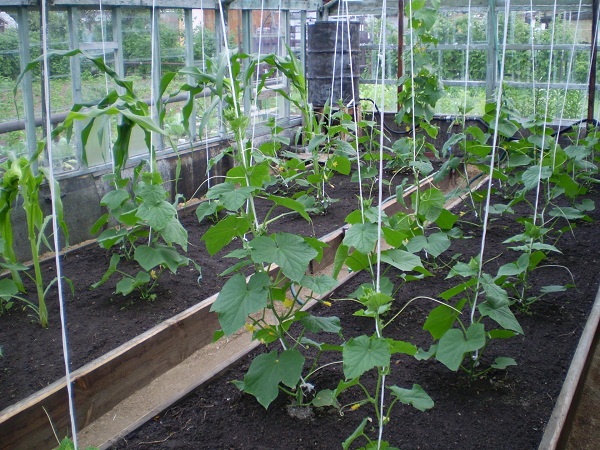 Growing cucumbers in greenhouse conditions and open areas is not much different, but there are still some nuances. Proper top dressing, one of the important conditions for obtaining a decent harvest. It is not enough just to apply different fertilizers, you need to do it on time and competently, focusing on the recommendations and needs of the plants.
Growing cucumbers in greenhouse conditions and open areas is not much different, but there are still some nuances. Proper top dressing, one of the important conditions for obtaining a decent harvest. It is not enough just to apply different fertilizers, you need to do it on time and competently, focusing on the recommendations and needs of the plants.
Content
Features of feeding cucumbers in the greenhouse: fertilizer schedule
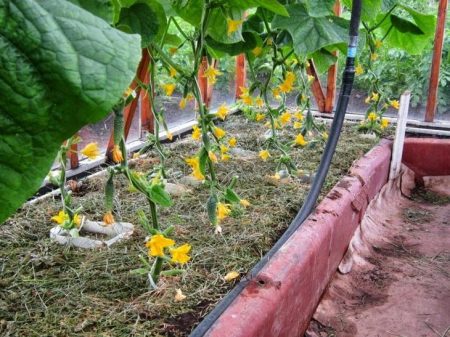 First of all, you need to consider that cucumbers have a short growing season. Fertilize them at least 3-4 times per season. The number of top dressings directly depends on the selected cucumber variety, as well as the quality and fertility of the soil. Poor soils are fertilized more often, however, a break between procedures should be at least two weeks.
First of all, you need to consider that cucumbers have a short growing season. Fertilize them at least 3-4 times per season. The number of top dressings directly depends on the selected cucumber variety, as well as the quality and fertility of the soil. Poor soils are fertilized more often, however, a break between procedures should be at least two weeks.
Fertilizer Schedule:
- For the first time, seedlings are fed even before planting in a permanent place, complex mineral fertilizers diluted with water are perfect for this. They observed the optimal proportions of macro and microelements for the growth and full development of seedlings.
- The second time fertilizers are applied when young plants adapt to new conditions. This usually does not occur earlier than 2 weeks after transplanting into the greenhouse. At this moment, seedlings are most in need of nitrogen, it is responsible for the development of roots and abundant growth of greenery.
- The next feeding is carried out 14 days after the previous one, at which time the plants spend a lot of energy. Solutions with a high content of potassium and phosphorus are perfect.
- The last time cucumbers are fertilized during the fruiting period, in order to get beautiful and tasty fruits, they add potassium substances. A solution of potassium sulfate or potassium nitrate is perfect.
If necessary, you can additionally feed the cucumbers in an extra-root way.
How to feed cucumbers after planting in a greenhouse
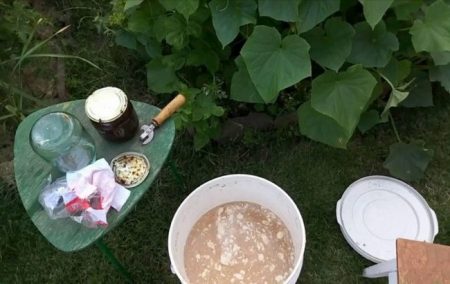 Fertilizers are applied 14 days after planting; mineral and organic substances with a high nitrogen content, which is necessary for cucumbers in this growth phase, are suitable for feeding. Of organic substances, bird droppings diluted with water 1:16 are preferred. Of mineral fertilizers, an aqueous urea solution (below) is perfect.
Fertilizers are applied 14 days after planting; mineral and organic substances with a high nitrogen content, which is necessary for cucumbers in this growth phase, are suitable for feeding. Of organic substances, bird droppings diluted with water 1:16 are preferred. Of mineral fertilizers, an aqueous urea solution (below) is perfect.
Structure:
- superphosphate 60 g;
- urea 1 tbsp. l;
- water 10 l;
Cooking:
Mineral components are added to the settled water and mixed thoroughly until completely dissolved.
Application:
Young seedlings are watered with a nutrient solution under the root, it is better to do this in the evening or in the early morning.
How to feed cucumbers during flowering
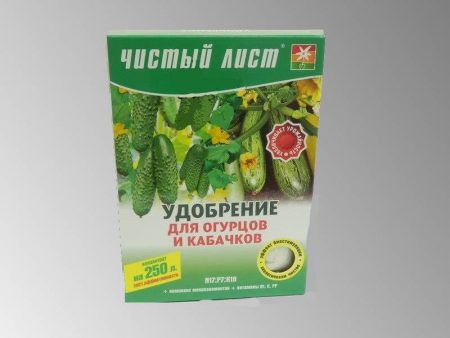 The most significant substances for the culture at this stage of development are potassium and phosphorus. Wood ash is distinguished by a high concentration of such substances, it does not contain chemistry, and saturates the bushes with all the necessary elements.You can also use simple or complex mineral fertilizers. Top dressing with a high nitrogen content is eliminated or introduced in minimal quantities. Solutions based on Ammofoski are perfect:
The most significant substances for the culture at this stage of development are potassium and phosphorus. Wood ash is distinguished by a high concentration of such substances, it does not contain chemistry, and saturates the bushes with all the necessary elements.You can also use simple or complex mineral fertilizers. Top dressing with a high nitrogen content is eliminated or introduced in minimal quantities. Solutions based on Ammofoski are perfect:
Structure:
- Ammofoska 25 g;
- Mullein 1l;
- water 10 l;
- any complex fertilizer 30 g;
Cooking:
Warm water is poured into the bucket and all the ingredients are added in turn. The resulting solution was mixed well.
Application:
With liquid fertilizer, water the bushes under the root in the evening or in the morning. Approximately 200 ml of solution is used per plant.
How to feed cucumbers during fruiting
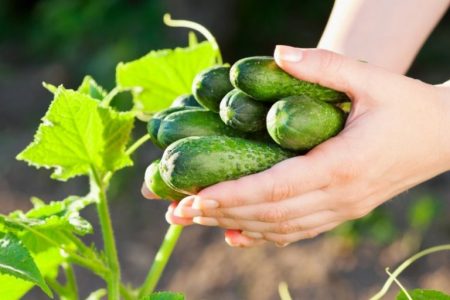 During this period, it is recommended to use only natural components - organic or folk remedies, so that chemicals do not accumulate in the fruits. Chemistry can negatively affect the nutritional qualities of fruits, especially if vegetables are intended for children to eat. Cucumbers respond positively to herbal infusions.
During this period, it is recommended to use only natural components - organic or folk remedies, so that chemicals do not accumulate in the fruits. Chemistry can negatively affect the nutritional qualities of fruits, especially if vegetables are intended for children to eat. Cucumbers respond positively to herbal infusions.
Structure:
- grass;
- water;
Cooking:
The tank is filled with any green grass, filled with warm water and insisted for a week. Before use, dilute with water 1:10.
Application:
The procedure is best done in cloudy weather. The resulting solution is watered cucumbers at the root, first you need to moisten the soil.
For fertilizing greenhouse cucumbers, it is better to use liquid top dressing, since dry ones due to the lack of rain may not dissolve completely.
How to feed cucumbers so that they do not turn yellow
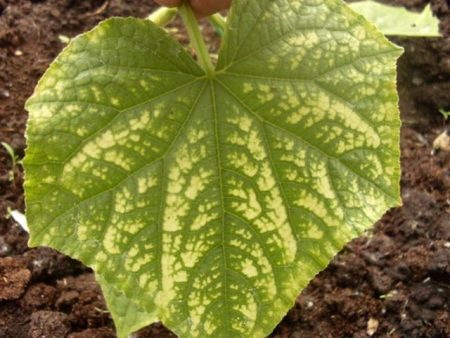 The leaves of the plants turn yellow for various reasons, this may be a shortage of any substances, errors in care or worsening weather conditions. Spraying young seedlings with a nutrient solution will help to solve the problem.
The leaves of the plants turn yellow for various reasons, this may be a shortage of any substances, errors in care or worsening weather conditions. Spraying young seedlings with a nutrient solution will help to solve the problem.
Ingredients for cooking:
- 30 drops of iodine;
- 20 grams of chopped laundry soap;
- 1 liter of cow's milk;
- 10 l water;
Cooking:
All components are added to warm water without chlorine and mixed thoroughly until completely dissolved. The collected rainwater heated in the sun is well suited.
Application:
The resulting liquid is treated with bushes approximately once every fourteen days, for the first time spraying of young seedlings is carried out at the stage of 3-4 leaves.
Types of fertilizers for cucumbers in the greenhouse
Plants cultivated in the open air receive nutrients not only when fertilizing, but also naturally. In greenhouse conditions, these elements are introduced only with top dressing. Therefore, in the shelter, cucumbers fertilize more often, the absence or insufficient number of fertilizing threatens soil depletion. They begin to use fertilizers before planting seedlings. Mineral and organic components are used for this. Good results are given by alternating top dressing. After the procedure, it is necessary to ventilate the greenhouse.
Organic fertilizers for greenhouse cucumbers
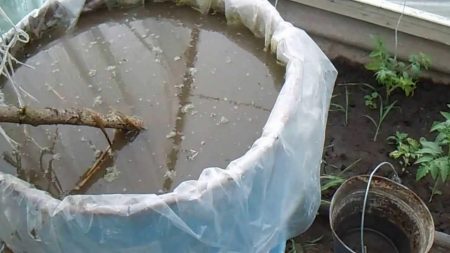 Organic substances have a good effect on the development of culture, in addition, they do not have chemistry, which is very important for some gardeners. You can use them throughout the entire growing season. Most often, solutions are used to feed cucumbers.
Organic substances have a good effect on the development of culture, in addition, they do not have chemistry, which is very important for some gardeners. You can use them throughout the entire growing season. Most often, solutions are used to feed cucumbers.
In fresh manure, a large amount of active nitrogen, it can harm plants, it can also contain viruses and bacteria. Therefore, it is laid in a compost pit for the winter or bred with water and wait until the solution ferments.
Wood ash
Great for greenhouse plants, it contains many vital substances for growth and development. In addition, ash is an effective prophylactic against fungal diseases. Preparing the solution is very simple, the cooking time is 24 hours.
Structure:
- 100 grams of ash;
- 10 l water;
Cooking:
The substance is added to clean, better filtered water at room temperature and insisted throughout the day. The solution is stirred periodically.
Application:
Used throughout the growing season, the interval between top dressing should be 10-14 days. The resulting fertilizer is watered under the root of cucumbers, trying not to fall on the foliage.
Herb Vitamin Shake
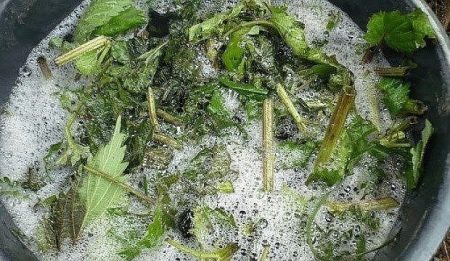 Firstly, such top dressing saves the budget, and secondly, it is prepared from natural ingredients and is very useful for cucumbers.
Firstly, such top dressing saves the budget, and secondly, it is prepared from natural ingredients and is very useful for cucumbers.
Structure:
- 1 kg of grass;
- 12 liters of water;
Cooking:
You can use any grass, quinoa, plantain, and nettle are perfect. Raw materials are cleaned from seeds and crushed. Pour hot, but not boiled water and insist 72 hours.
Application:
Filter before use. Consumption: for 1 square meter of landings, 2-3 liters of solution will be needed.
Mullein
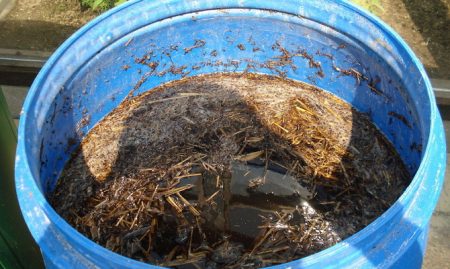 It saturates plants with nitrogen and other useful substances, mainly it is used as a third top dressing.
It saturates plants with nitrogen and other useful substances, mainly it is used as a third top dressing.
Structure:
- manure;
- water;
Cooking
For the solution, take one part of the mullein and ten parts of water, mix well and insist for two weeks in a warm place. During this time, the liquid should ferment, this will signal the appearance of bubbles.
Application:
Before use, the resulting solution is again diluted 1:10 and used for root dressing. It is better to pre-moisten the soil.
With regular application of nutrients to the soil, cucumbers are much less likely to be affected by diseases and pests.
Mineral fertilizers for greenhouse cucumbers
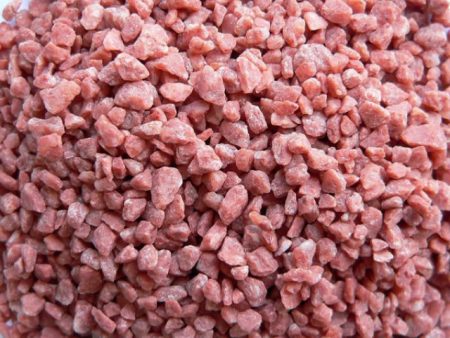 Mineral fertilizing is used throughout the growing season, taking into account what substances the culture needs at the time of their application. You can use both mineral elements individually and complex fertilizers. You need to use them carefully, observing the dosage, an overabundance of certain trace elements can have unpleasant consequences for cucumbers, and even lead to the death of the plant. The first top dressing can be carried out with the following composition.
Mineral fertilizing is used throughout the growing season, taking into account what substances the culture needs at the time of their application. You can use both mineral elements individually and complex fertilizers. You need to use them carefully, observing the dosage, an overabundance of certain trace elements can have unpleasant consequences for cucumbers, and even lead to the death of the plant. The first top dressing can be carried out with the following composition.
Ingredients:
- double superphosphate;
- potassium sulfate;
- ammonium nitrate;
Cooking
10 liters of warm water are poured into a 12 liter container, 15 grams of ammonium nitrate, 25 grams of superphosphate and 20 g of potassium sulfate are added. Then the solution is stirred until all components are completely dissolved.
Application:
Use a solution for irrigation. The amount of fertilizer obtained is enough for about twenty bushes.
For the first top dressing of the culture, Ammofoska is perfect; there are no nitrates and chlorine hazardous to health in it. Fertilizer is used for any type of soil. It contains a lot of nitrogen, potassium and phosphorus.
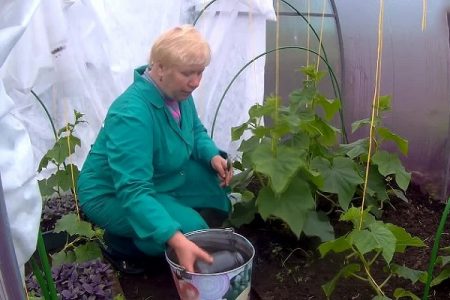
If during the flowering period it is noticed that the plants have weakened, the situation can be corrected by spraying the aerial parts of the plants with a solution of superphosphate. Preparing it is quite simple, but it is better to do it a day before the procedure.
Structure:
- superphosphate;
- water;
Cooking:
65 grams of the substance is poured with a liter of hot water, insisted for 24 hours, stirring occasionally. After the allotted time, another 9 liters of warm water are added to the container with the solution.
Application:
They process cucumber bushes with a sprayer in the evening or in the morning.
Types of feeding cucumbers in a greenhouse
For culture, root dressing is more often used. But in critical situations or when plants for one reason or another cannot absorb substances, they are sprayed with nutrient solutions. This top dressing is called foliar. They use organic and mineral fertilizers, as well as folk remedies.
Root feeding
They are used subject to steady warm weather. For the procedure, choose morning or evening time. Water the seedlings carefully so that the solution does not fall on the leaves.Before introducing nutrients, it is recommended to moisten the soil beforehand so that the substances penetrate the plant root system faster.
Foliar top dressing
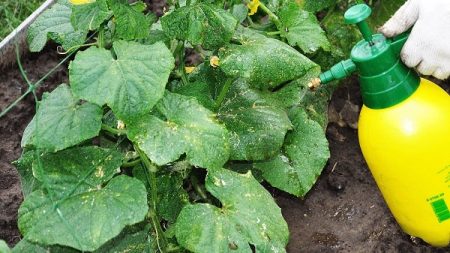 They are made if the summer is cool, and also if the plants have poorly developed or damaged roots. In such situations, plants will not cope with the absorption of nutrients. It is better to spray in the evening, so that the leaves absorb micronutrients during the night. Fertilizer concentration is halved, and the ground part of the crop is treated with a spray with small drops. Experienced gardeners are advised to use adhesives to keep the liquid on the leaves for as long as possible. With foliar top dressing, plants get the necessary substances much faster, which is very important for their acute deficiency. Before the procedure, it is recommended to wear gloves and protect the airways with a mask.
They are made if the summer is cool, and also if the plants have poorly developed or damaged roots. In such situations, plants will not cope with the absorption of nutrients. It is better to spray in the evening, so that the leaves absorb micronutrients during the night. Fertilizer concentration is halved, and the ground part of the crop is treated with a spray with small drops. Experienced gardeners are advised to use adhesives to keep the liquid on the leaves for as long as possible. With foliar top dressing, plants get the necessary substances much faster, which is very important for their acute deficiency. Before the procedure, it is recommended to wear gloves and protect the airways with a mask.
What to do if cucumbers began to lag behind in development?
Each gardener at least once found himself in a situation where the seedlings, for no apparent reason, began to lag behind in development. This is often due to a lack of nutrients. Complex mineral fertilizing will save the situation, they contain all the trace elements necessary for the plant in the optimal ratio.
How to understand what the plant lacks?
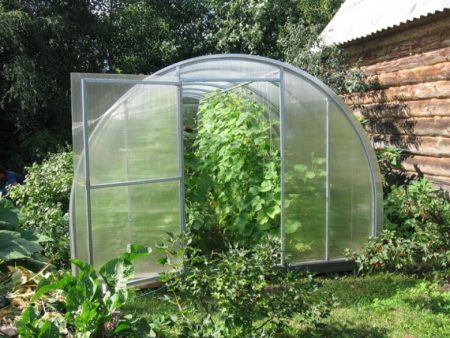 Often seedlings begin to lag behind in development, its appearance becomes not attractive, and the leaves turn yellow or fade. First, inexperienced gardeners sin on the appearance of pests or the development of diseases. But not finding signs of illness, they are at a loss, which provoked a deterioration in the state of seedlings. It turns out that the reason is simple - it is a lack or excess of fertilizers.
Often seedlings begin to lag behind in development, its appearance becomes not attractive, and the leaves turn yellow or fade. First, inexperienced gardeners sin on the appearance of pests or the development of diseases. But not finding signs of illness, they are at a loss, which provoked a deterioration in the state of seedlings. It turns out that the reason is simple - it is a lack or excess of fertilizers.
The soil in the greenhouse will help to understand exactly what elements are missing cucumbers:
- N deficiency often occurs on sod-podzolic soils;
- deficiency of B, K, and Cu is often found on light sandy and sandy loamy soils;
- Mn deficiency can occur on alkaline, peaty and carbonate soils;
- on peatlands located in the low part of the site, a Cu deficiency often arises;
Potassium Deficiency (K)
It is especially necessary during the period of ripening and fruiting. With its shortage, the palatability of the fruit is significantly degraded. Their shape also changes, near the stalk cucumbers narrow and become clumsy. The lack of substance is reflected on the leaves, they dry on the edges. Correct the situation by abundant watering, if after 2-3 days the situation has not changed, a solution of ash or potassium sulfate should be added.
Nitrogen deficiency (N)
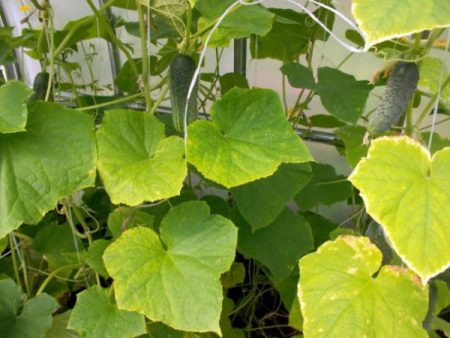 Any plants experience a need for nitrogen during the entire growth period, and cucumbers are no exception. Nitrogen is especially needed when greenery grows and roots develop. Its lack is strongly reflected in culture. The leaves brighten at first, if you do not take action, they turn yellow and fall off. Stem growth stops, fruits are not tied. The color of the fruit also changes, they become pale. With an excess of substance, the skin of the vegetable acquires a yellowish tint and becomes covered with small spots. With nitrogen deficiency, foliar top dressing with urea can be used. Prepare it from 10 liters of warm water and 15 g of substance. During the fruiting period, it is better to use organics, for example, herbal infusion.
Any plants experience a need for nitrogen during the entire growth period, and cucumbers are no exception. Nitrogen is especially needed when greenery grows and roots develop. Its lack is strongly reflected in culture. The leaves brighten at first, if you do not take action, they turn yellow and fall off. Stem growth stops, fruits are not tied. The color of the fruit also changes, they become pale. With an excess of substance, the skin of the vegetable acquires a yellowish tint and becomes covered with small spots. With nitrogen deficiency, foliar top dressing with urea can be used. Prepare it from 10 liters of warm water and 15 g of substance. During the fruiting period, it is better to use organics, for example, herbal infusion.
The introduction of ammonium nitrate after the beginning of flowering can lead to the accumulation of nitrates in cucumbers.
Magnesium Deficiency (Mg)
With an insufficient amount of substance in the soil, the leaves of the plant are colored unevenly, light and dark spots stand out on them.
Calcium Deficiency (Ca)
A sign of calcium deficiency is pale leaves framed by a yellowish border. Over time, they fade and curl up.
Boron deficiency (B)
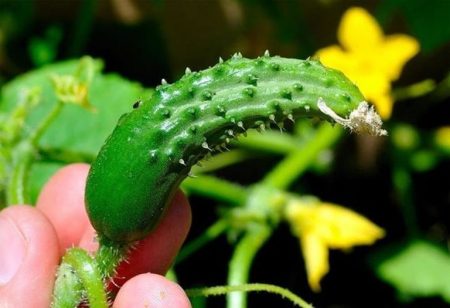 Its deficiency is manifested by falling flowers and ovaries.On the formed fruits, you can see a bright strip, cucumbers have a curved shape. A yellow border appears on the leaves.
Its deficiency is manifested by falling flowers and ovaries.On the formed fruits, you can see a bright strip, cucumbers have a curved shape. A yellow border appears on the leaves.
Phosphorus deficiency (P)
Plants need phosphorus at every stage of growth. Its insufficient amount of substance is signaled by the slower growth of the lashes, fading and discoloration of the foliage. The veins on the sheets turn purple, and in the advanced stages they completely darken and fall off. In an emergency, plantings are treated with a solution of Ammofoski or Superphosphate, it is prepared from one tablespoon of a substance and a bucket of settled water. Pathology is quite rare, it is mainly associated with the planting of seedlings in poor soil with increased acidity.
With an excess of phosphorus, potassium is poorly absorbed.
Molybdenum Deficiency (Mo)
The lack of the element is mainly manifested in marshy areas, when planting crops in lowlands with stagnant water. The bushes become weak and chloritic, and the fruits decay, never having time to ripen. If the soil contains heavy metals or a large amount of ammonia nitrogen, this can also lead to a molybdenum deficiency.
Iron Deficiency (Fe)
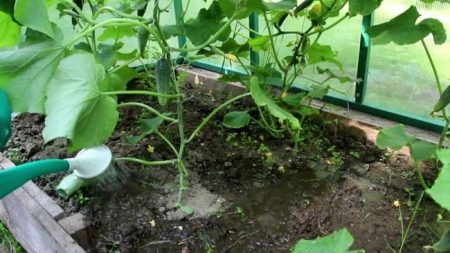 Its lack is manifested by growth retardation and flowering, as well as lightening of the top of the plant. The foliage along the veins has a pale green color. You can fix the problem using root dressing with 5% solution of iron sulfate.
Its lack is manifested by growth retardation and flowering, as well as lightening of the top of the plant. The foliage along the veins has a pale green color. You can fix the problem using root dressing with 5% solution of iron sulfate.
Deficiency of copper (Cu), zinc (Zn) and manganese (Mn)
Zinc deficiency is manifested by uneven yellowing and asymmetric leaves. Replenish the missing element in the soil by adding zinc sulfate. A 0.04% solution is prepared for spraying.
The lack of a sufficient amount of manganese in the soil is manifested by the bending of the leaves and their acquisition of a dark green color. With a high manganese content, the plant may die.
Obvious signs of copper deficiency are blanching of leaves and wilting of flowers, shoots are poorly developed. Spring treatment of the soil with 1% copper sulfate will help to prevent the situation. Also, this procedure is an excellent preventive measure of fungal diseases.
Conclusion
Fertilizing cucumbers in a greenhouse has its own characteristics, they should be taken into account when growing crops in a shelter. To get a decent crop, you need to follow the schedule for making nutrient components, and know what element the plant needs at a given time.




 Armenian cucumber with melon flavor: description and characteristics, reviews
Armenian cucumber with melon flavor: description and characteristics, reviews Do-it-yourself vertical beds for cucumbers: schemes, photos
Do-it-yourself vertical beds for cucumbers: schemes, photos Hollow cucumbers: reasons for the appearance of hollow, what to do
Hollow cucumbers: reasons for the appearance of hollow, what to do Which manure is best for cucumbers: application, how to breed
Which manure is best for cucumbers: application, how to breed